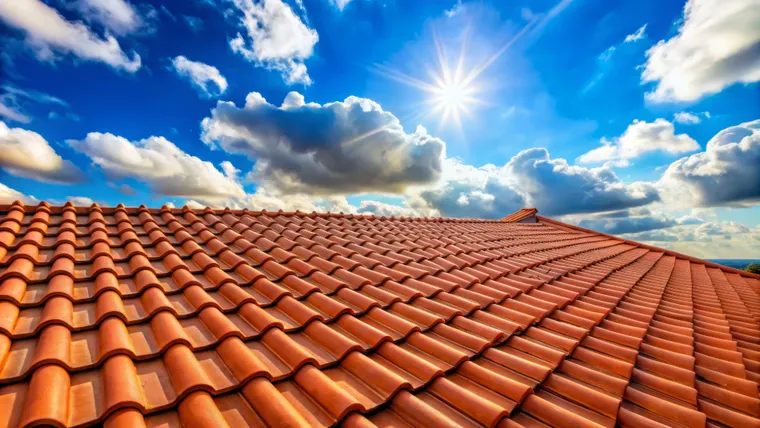A Modern, Eco-Friendly Upgrade
Cool roofs are a straightforward, modern way to improve your home’s energy efficiency, boost comfort, and help the environment at the same time.
By reflecting more sunlight and absorbing less heat than standard roofs, these innovative options can keep your home cooler, lower your energy bills, and even reduce the “urban heat island” effect that makes cities hotter than surrounding areas. Understanding what cool roofs are, how they work, and the different types available can help you make a smart, eco-friendly choice.
What Are Cool Roofs and How Do They Work?
So, what exactly is a cool roof? Think of it this way: just like wearing a light-colored shirt on a sunny day keeps you cooler, a cool roof uses materials designed to reflect more sunlight and release heat more effectively than a traditional roof.
Some of these roofs can be up to 50°F cooler on their surface, which can mean real savings on energy bills—especially during those blistering summer months.
It’s not just about cost, though. Cool roofs help create a more comfortable indoor environment, even if your home doesn’t have air conditioning. They also help extend the life of your roofing materials by reducing how much they expand and contract in response to temperature changes.
For real estate professionals, real estate continuing education (CE) courses offer programs now often covering sustainable home features, including cool roofs. These courses help agents stay informed about emerging trends that appeal to today’s eco-conscious buyers.
Environmental Benefits of Cool Roofs
Beyond the obvious benefits to your home, cool roofs have a positive impact on the world around you. By reflecting sunlight and keeping outdoor temperatures lower, they can help ease the intensity of urban heat islands, decrease power plant emissions by reducing energy demand, and even contribute to mitigating global warming. Plus, there may be rebates and incentives that make upgrading to a cool roof more affordable than you’d expect.
Exploring Cool Roofing Options
If you’re wondering what your options are, don’t worry—there’s a cool roofing solution for almost any home style.
For steep-sloped roofs, you can choose light-colored asphalt shingles, naturally reflective wood shingles, polymer or metal shingles with reflective coatings, and even clay or concrete tiles specially made to bounce back more sunlight.
If your home has a low-sloped roof, you might look into single-ply membranes, built-up roofs with reflective coatings, or spray polyurethane foam systems that naturally work well with reflective coatings.
Factors to Consider When Choosing a Cool Roof
Choosing the right cool roof material for your home depends on factors like your climate, the slope of your roof, and how well your home is insulated.
While a white roof will reflect the most sunlight, many “cool-colored” materials can still reflect a substantial portion of the sun’s rays without forcing you to abandon a color you love.
You can install a cool roof when you’re building a new home, replacing an old roof, or even retrofitting your current roof with reflective coatings, if compatible.
For real estate professionals looking to highlight these advantages to clients, enrolling in a real estate CE/license renewal course can provide even more valuable insights into how environmentally friendly roofing choices can influence property values.
Important Considerations and Challenges
Of course, there are a few things to keep in mind. In colder climates, a cool roof may mean you’ll spend a bit more on heating in the winter, although better insulation can help offset that. Moisture control is also important, as certain conditions can increase condensation risks. And while white or light-colored roofs provide the best performance, they might not fit every homeowner’s style preferences—though fortunately, cool-colored options can strike a nice balance.
Cost and Long-Term Value
From a financial standpoint, a cool roof can be an excellent long-term investment, especially if you’re already planning to replace your roof. Even if retrofitting an existing roof costs more upfront, you might find that the energy savings and the extended life of your roofing materials justify the expense. Environmentally, the more people choose cool roofs in urban areas, the more we collectively reduce local temperatures, smog, and greenhouse gas emissions.
Determining If a Cool Roof Is Right for You
If you live in a hot climate, have an aging roof, or simply want to cut down on cooling bills while making your home more comfortable, a cool roof might be just the solution. In colder regions, you’ll need to weigh the cost of potential winter heating against the summer savings.
Compared to green roofs, which also deliver energy savings and environmental benefits through vegetation, cool roofs are generally less costly and simpler to maintain, making them a practical choice for many homeowners.
Getting Started With Your Cool Roof
If you’re interested in taking the plunge, start by exploring your options, talking to roofing professionals, and looking into available rebates or tax credits in your area.

